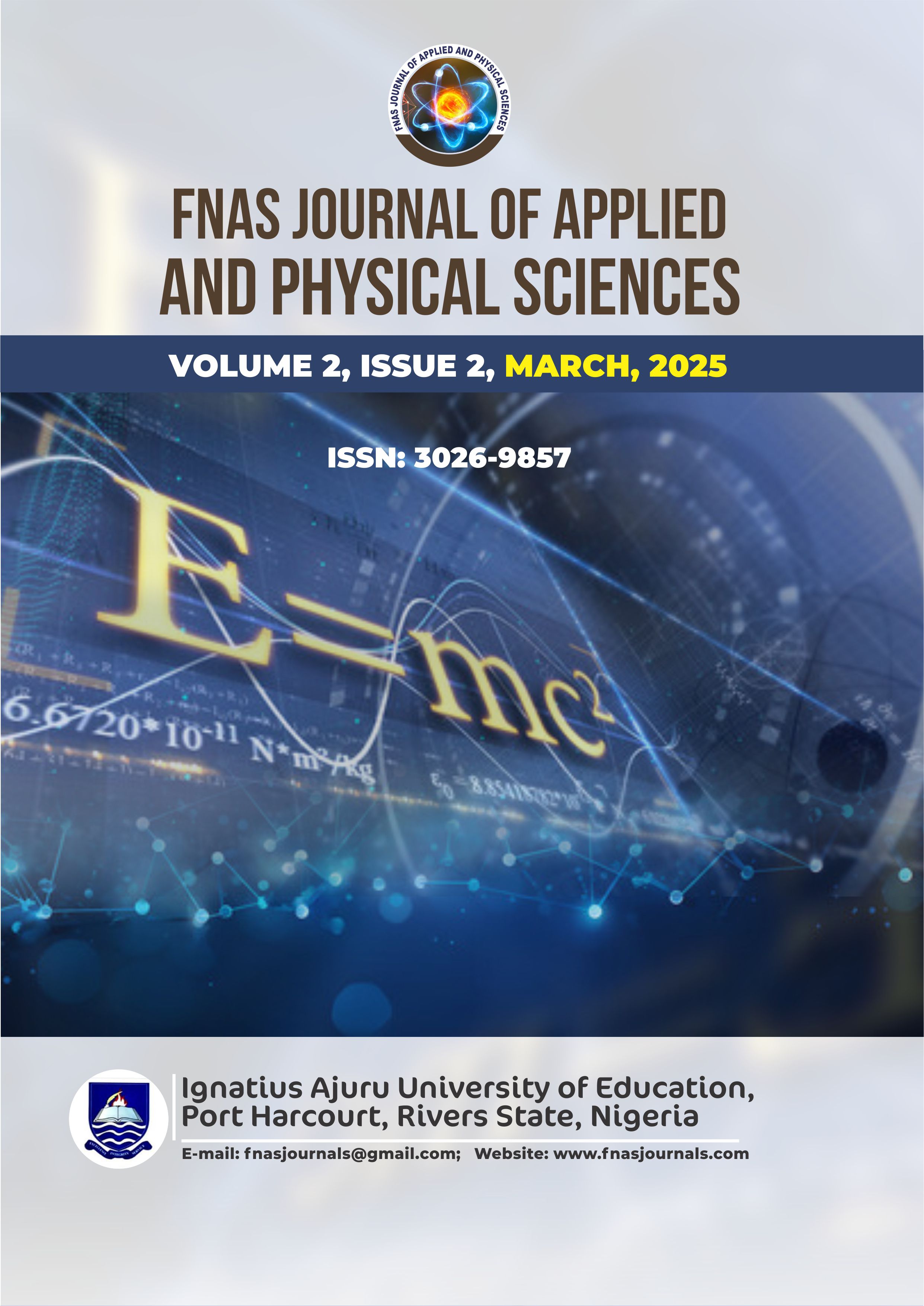Adsorption Characteristics of Selected Dyes Using Activated Carbon Derived from Piliostigma thonningii (Fabaceae: Cercidoideae) Stem
Keywords:
Adsorbent, Adsorption, Column Chromatography, Dye, Flow RateAbstract
Adsorption characteristics include the initial dye concentration effect, flow rate and adsorbent dose of dyes using activated Piliostigma thonningii Charcoal (PTC) were studied. The adsorption process of the dyes was done using column chromatographic technique at constant temperature and fixed pH of the dye’s concentration. Optimization of the column adsorption parameters was conducted, and the maximum percentage removal was attained through setting the level of variables of the adsorption process to initial 100mg/L MB and BM dye concentrations, 30ppm MD dyes and a flow rate of 3mL/min. With lower initial concentration, higher bed height of the adsorbent and lower feed flow rate, the performance of the fixed-bed adsorption system was found to be better. With the highest bed height of 28cm (10g adsorbent dose), maximum adsorption capacity was achieved. The research can help in recycling the wastewater discharged by the textile industries, which will help in reducing the level of water scarcity for industrial use.
References
Ahmad, A.A., & Hameed, B.H. (2010). Fixed-bed adsorption of reactive azo dye onto granular activated carbon prepared from waste, J. Hazard. Mater. 175: 298–303.
Alharthi, M., Hanif, I., & Alamoudi, H. (2022). Impact of environmental pollution on human health and financial status of households in MENA countries: Future of using renewable energy to eliminate the environmental pollution. Renewable Energy, 190, 338-346.
Carlotti, J.N. (2021). Absorbent Household Materials for the Collection of Ignitable Liquid Residues from Surfaces of Varying Porosity. Eastern Kentucky University,
Garg, A., & Chopra, L. (2022). Dye Waste: A significant environmental hazard. Materials Today: Proceedings, 48, 1310-1315.
Gupta, V.K., & Rastogi A. (2009). Biosorption of hexavalent chromium by raw and acid-treated green alga Oedogonium hatei from aqueous solutions. J Hazard Mater 163:396–402
Han, R.P., Wang, Y., Zhao X., Wang, Y.F., Xie F.L., Cheng J.M., & Tang, M.S. (2009). Adsorption of methylene blue by phoenix tree leaf powder in a fixed-bed column: Experiments and prediction of breakthrough curves, Desalination 245 : 284–297
Ibrahim, M.B., & Mohammed, M.B. (2017). Dynamic adsorption studies for the removal of Cd (II) and Ni (II) from aqueous solutions using mahogany leaves. ChemSearch Journal, 8(1), 1-12.
Jain, A.K., & Suhas, B.A. (2002). Methylphenols removal from water by low-cost adsorbents, Journal of Colloid and Interface Science, 251, 39–45.
Maheshwari, K., Agrawal, M., & Gupta, A. (2021). Dye pollution in water and wastewater. Novel materials for dye-containing wastewater treatment, 1-25.
Moorthy, A.K., Shukla, S.P., Govindarajan, R.B., Kumar, K., & Bharti, V.S. (2022). Application of microalgal physiological response as biomarker for evaluating the toxicity of the textile dye alizarin red S. Bulletin of Environmental Contamination and Toxicology, 109(2), 401-408.
Mustafa, T.Y., Tushar, K.S., Sharmeen A., & Ang, H.M. (2014). Fixed-bed dynamiccolumn adsorption study of methylene blue (MB) onto pine cone, Desalination and Water Treatment,: 1- 14 DOI:10.1080/19443994.2014.924034
Nachiyar, C.V., Rakshi, A., Sandhya, S., Jebasta, N.B.D., & Nellore, J. (2023). Developments in treatment technologies of dye-containing effluent: A review. Case Studies in Chemical and Environmental Engineering, 100339.
Ofomaja, A., Naidoo, E.B., & Modise, S.J. (2009). Removal of copper (II) from aqueous solution by pine and base modified pine cone powder as biosorbent, J. Hazard. Mater. 168: 909–917
Pinheiro, L.R.S., Gradíssimo, D.G., Xavier, L. P., & Santos, A.V. (2022). Degradation of azo dyes: bacterial potential for bioremediation. Sustainability, 14(3), 1510.
Sadaf, S., & Bhatti, H.N. (2014). Evaluation of peanut husk as a novel, low cost biosorbent for the removal of indosol orange RSN dye from aqueous solutions: Batch and fixed bed studies, Clean Technol. Environ. Policy 16: 527–544.
Varjani, S., Rakholiya, P., Shindhal, T., Shah, A.V., & Ngo, H.H. (2021). Trends in dye industry effluent treatment and recovery of value added products. Journal of Water Process Engineering, 39, 101734.
Wei, C., Wu, H., Kong, Q., Wei, J., Feng, C., Qiu, G., . . . Li, F. (2019). Residual chemical oxygen demand (COD) fractionation in bio-treated coking wastewater integrating solution property characterization. Journal of environmental management, 246, 324-333.





